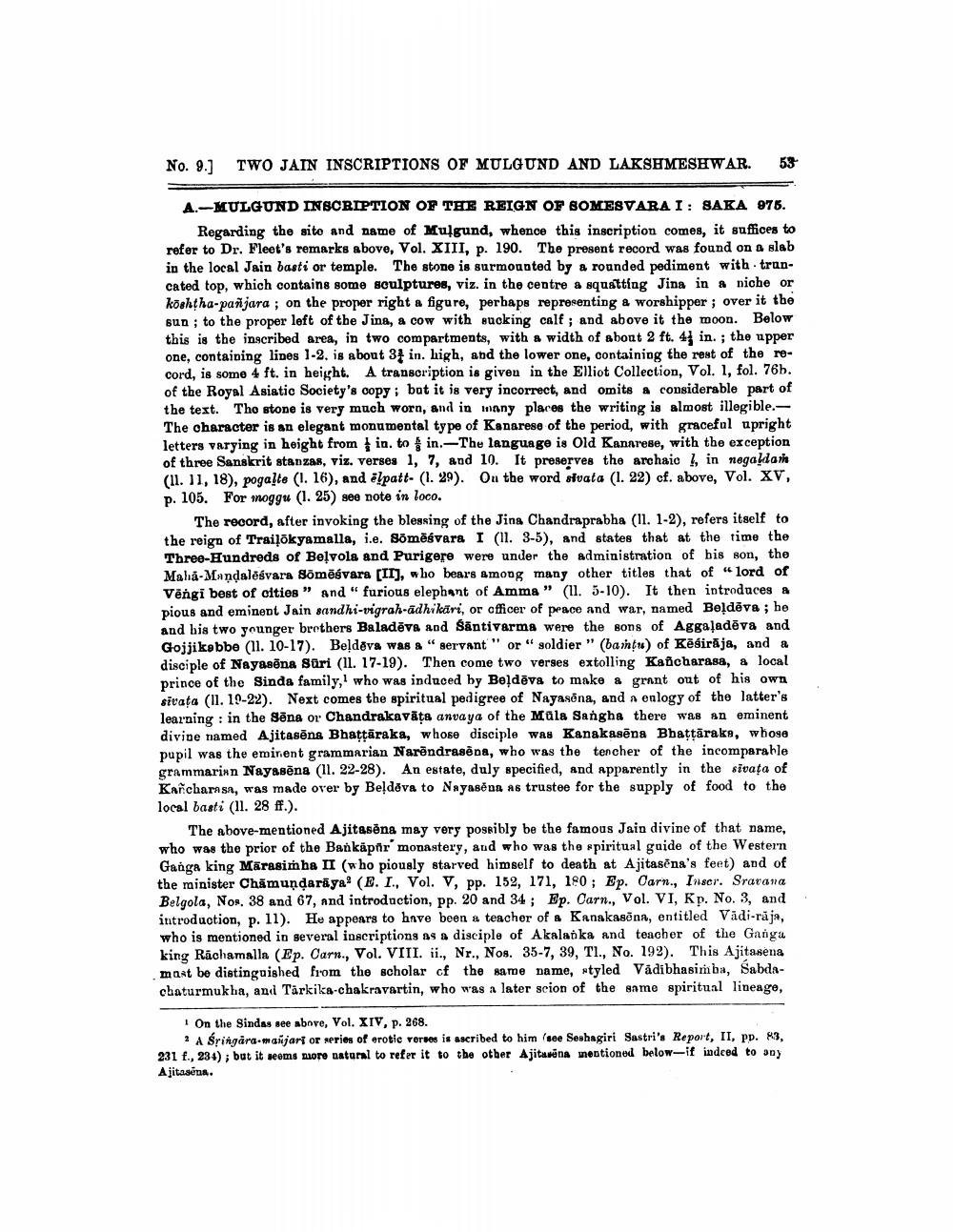________________
No. 9.] TWO JAIN INSCRIPTIONS OF MULGUND AND LAKSHMESHWAR. 53
A.-MULGUND INSCRIPTION OF THE REIGN OF BOMESVARAI: SAKA 075.
Regarding the site and name of Mulgund, whence this inscription comes, it suffices to refer to Dr. Fleet's remarks above, Vol. XIII, p. 190. The present record was found on & slab in the local Jain basti or temple. The stone is surmounted by a rounded pediment with trancated top, which contains some sculptures, viz. in the centre a squatting Jina in & niche or koshtha-pañjara ; on the proper right a figure, perhaps representing a worshipper ; over it the sun; to the proper left of the Jina, a cow with sucking calf; and above it the moon. Below this is the inscribed area, in two compartments, with a width of about 2 ft.4} in. ; the upper one, containing lines 1-2. is about 34 in. high, and the lower one, containing the rest of the record, is some 4 ft. in height. A transcription is giveu in the Elliot Collection, Vol. 1, fol. 76b. of the Royal Asiatic Society's copy; but it is very incorrect, and omits a considerable part of the text. The stone is very much worn, and in many places the writing is almost illegible.The character is an elegant monumental type of Kanarese of the period, with gracefal upright letters varying in height from in. to in.-The language is Old Kannrese, with the exception of three Sanskrit stanzas, viz. verses 1, 7, and 19. It preserves the archaic !, in negalla (11. J1, 18), pogaļto (1. 16), and alpatt- (1. 29). On the word suala (1. 22) cf. above, Vol. XV, p. 105. For noggu (I. 25) seo note in loco.
The record, after invoking the blessing of the Jina Chandraprabha (11. 1-2), refers itself to the reign of Traiļokyamalla, i.e. Sömēsvara I (11. 3-5), and states that at the time the Three Hundreds of Beļvola and Purigere were under the administration of bis son, the Maha-Mandalēsvara Sömēsvara (IT), who bears among many other titles that of " lord of Vēngi best of cities" and "furious elephant of Amma" (II. 5-10). It then introduces a pious and eminent Jain sandhi-vigrah-adhikari, or officer of peace and war, named Beļdēva ; he and his two younger brothers Baladěva and Sāntivarma were the song of Aggaladēva and Gojjikabbe (11. 10-17). Beldeva was & " servant " or "soldier" (baitu) of Kēsirāja, and a disciple of Nayasına Süri (11. 17-19). Then come two verses extolling Kancharasa, a local prince of the Sinda family, who was induced by Beldēva to make a grant out of his own sivata (11. 19-22). Next comes the spiritual pedigree of Nayasõna, and a enlogy of the latter's learning: in the Sēna or Chandrakavāța anvaya of the Mala Sangha there was an eminent divine named Ajitasēna Bhattāraka, whose disciple was Kanakasēna Bhattārake, whose pupil was the eminent grammarian Narēndrasena, who was the tencher of the incomparable grammarixn Nayasēna (1l. 22-28). An estate, duly specified, and apparently in the sivata of Karcharasa, was made over by Beļdēva to Nayasēna as trustee for the supply of food to the local basti (1l. 28 ff.).
The above-mentioned Ajitasēna may very possibly be the famous Jain divine of that name, who was the prior of the Bankäpar monastery, and who was the spiritual guide of the Western Ganga king Mārasimha II (who piously starved himself to death at Ajitasena's feet) and of the minister Chămundarāya (E. I., Vol. V, pp. 152, 171, 180; Ep. Carn., Inscr. Sravana Belgola, Nos. 38 and 67, and introduction, pp. 20 and 34 ; Ep. Carn., Vol. VI, Kp. No. 3, and introduction, p. 11). He appears to have been a teacher of a Kinakasõna, entitled Vädi-raja, who is mentioned in several inscriptions as a disciple of Akalanka and teacher of the Ganga king Rachamalla (Ep. Carn., Vol. VIII. ii., Nr., Nos. 35-7, 39, Ti., No. 192). This Ajitasena mast be distinguished from the scholar of the same name, styled Vådibhasimba, Sabdachaturmukha, and Tärkika-chakravartin, who was a later scion of the same spiritual lineage,
1 On the Sindas see above, Vol. XIV, p. 268.
? A Sringara-majjart or series of erotie verses is ascribed to him 'see Seshagiri Sastri's Report, II, pp. 43, 231 £., 234); but it seems noro untural to refer it to the other Ajitaw na mentioned below-if indeed to any Ajitasena.




